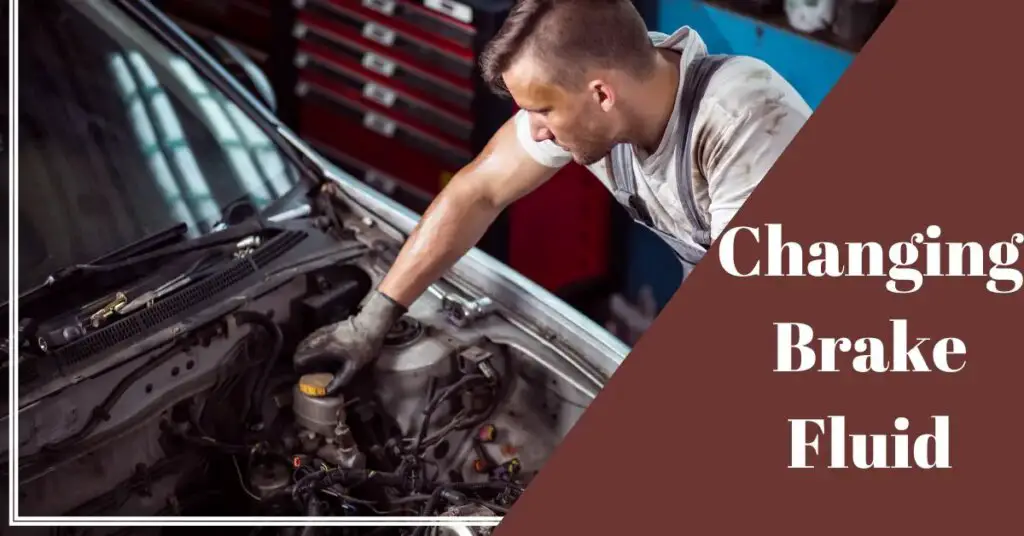Your vehicle’s braking system is its lifeline for safety, making brake fluid a crucial element for reliable performance.
In this concise guide, we’ll delve into the importance of brake fluid, the types available, and the step-by-step process of changing it. Whether you’re a DIY enthusiast or considering professional help, understanding the ins and outs of brake fluid maintenance is essential.
Table of Contents
What is Brake Fluid?
Brake fluid is a specialized hydraulic fluid that plays a crucial role in the operation of a vehicle’s braking system. It is designed to transmit force and pressure from the driver’s foot on the brake pedal to the brake components near the wheels, ultimately enabling the vehicle to slow down or come to a complete stop.
Brake fluid is typically a glycol-ether based or silicone-based liquid, specifically formulated to have a high boiling point and low compressibility. This is important because the fluid needs to maintain its properties and performance even under high temperatures and pressure, which are generated during the braking process.
Role of Brake Fluid in Braking System
The braking system of a vehicle is a complex arrangement of components that work together to slow down or stop the vehicle. The brake fluid serves several critical roles within this system:
Hydraulic Transmission of Force
When the driver presses the brake pedal, the force applied is transferred through the brake fluid to the brake components located at each wheel. This force causes the brake calipers (in disc brakes) or wheel cylinders (in drum brakes) to engage, creating friction between the brake pads (or shoes) and the brake rotor (or drum), which slows down the vehicle.
Heat Dissipation
The braking process generates a significant amount of heat due to the friction between the brake components. Brake fluid has a high boiling point to withstand these high temperatures without vaporizing. If the fluid were to vaporize, it could lead to a loss of braking performance, commonly known as “brake fade.”
Corrosion Prevention
Brake fluid also plays a role in preventing corrosion within the braking system. It helps protect metal brake components from rust and corrosion, which could negatively impact the system’s performance and longevity.
Hydraulic Amplification
Brake fluid is an incompressible fluid, which means that it cannot be easily compressed. This property allows it to efficiently transmit the force applied on the brake pedal to the brake components, ensuring a reliable and responsive braking action.
Sealing and Lubrication
Brake fluid also provides sealing and lubrication to the various components of the braking system, such as the master cylinder, brake lines, and calipers. This helps maintain the integrity of the system and ensures its smooth operation.
Factors Impacting Brake Fluid Quality
Heat and Moisture Exposure
Brake fluid is exposed to high temperatures generated during braking, which can lead to fluid degradation over time. Moisture can also seep into the braking system through the brake lines, causing the brake fluid to absorb water. This moisture contamination can lower the boiling point of the fluid and reduce its effectiveness.
Contaminants and Debris Accumulation
Over time, contaminants such as dirt, dust, and debris can enter the braking system. These particles can compromise the quality of the brake fluid and potentially damage components like brake calipers and master cylinders.
Age and Oxidation
Brake fluid can undergo oxidation due to prolonged exposure to heat and air. As it oxidizes, its chemical properties change, and it becomes less effective at transmitting force and heat.
Signs It’s Time to Change Brake Fluid
Decreased Braking Performance
If you notice that your vehicle’s braking performance has decreased, such as longer stopping distances or less responsive braking, it could be a sign that the brake fluid has degraded and is not transmitting force effectively.
Spongy Brake Pedal
A spongy or soft brake pedal that goes too far down before engaging the brakes can indicate air in the brake lines or a problem with the brake fluid. Air bubbles can form in the brake fluid, affecting its hydraulic properties.
Discolored Brake Fluid
Brake fluid is typically clear or slightly yellowish when new. If you check the brake fluid and notice that it has turned dark or murky, it may be contaminated and in need of replacement.
Boiling Point Test
Professional mechanics can perform a boiling point test on your brake fluid to determine its quality. Brake fluid with a significantly reduced boiling point due to moisture contamination may need to be replaced.
Scheduled Maintenance
Manufacturers often recommend specific intervals for changing brake fluid. Check your vehicle’s owner’s manual for the recommended maintenance schedule.
Visible Contaminants
If you can see particles or debris in the brake fluid reservoir, it’s a clear sign that the fluid is contaminated and should be changed.
Unusual Odors
If you notice a burnt or unusual odor when applying the brakes, it could indicate that the brake fluid has absorbed moisture and is overheating.
Regular brake fluid maintenance, including flushing and replacing the fluid as recommended by the vehicle manufacturer, is essential for preserving the effectiveness of your vehicle’s braking system and ensuring your safety on the road.
Benefits of Regular Brake Fluid Maintenance
Regular brake fluid maintenance offers several benefits that contribute to the overall safety and performance of your vehicle’s braking system:
1. Enhanced Braking Efficiency
Regularly changing your brake fluid helps maintain its optimal performance characteristics, such as its high boiling point and hydraulic properties. This ensures that the brake fluid can effectively transmit force from the brake pedal to the brake components, resulting in more responsive and consistent braking. Enhanced braking efficiency is crucial for safe driving, especially during sudden stops or emergency situations.
2. Extended Brake System Lifespan
Brake fluid maintenance helps prevent corrosion and deterioration of critical brake system components, such as the master cylinder, brake lines, calipers, and wheel cylinders. By reducing the buildup of moisture and contaminants, you can extend the lifespan of these components. This not only saves you money on potential repairs but also contributes to the overall longevity of your vehicle.
3. Improved Safety on the Road
Maintaining your vehicle’s braking system in optimal condition is paramount for your safety and the safety of others on the road. Regular brake fluid maintenance helps ensure that your brakes are functioning as intended, reducing the risk of brake failure or diminished braking performance. Properly functioning brakes provide you with the confidence and control needed to navigate various driving conditions and potential hazards.
4. Prevention of Brake Fade
Brake fade occurs when the braking performance deteriorates due to the excessive heat generated during prolonged or intense braking. Brake fluid with a high boiling point can better withstand these high temperatures, reducing the likelihood of brake fade. By regularly changing the brake fluid, you help maintain its heat-resistant properties, ensuring consistent braking performance over time.
5. Cost Savings
Investing in regular brake fluid maintenance can help you avoid more expensive repairs or replacements down the line. Corrosion and damage caused by degraded brake fluid can lead to costly repairs to brake components and the braking system as a whole. By proactively maintaining your brake fluid, you can prevent such issues and save money in the long run.
6. Compliance with Manufacturer Recommendations
Following the recommended brake fluid maintenance schedule outlined in your vehicle’s owner’s manual ensures that you’re adhering to the manufacturer’s guidelines for optimal performance. This can also contribute to maintaining the vehicle’s warranty coverage.
Regular brake fluid maintenance goes beyond simple fluid replacement – it’s a proactive measure that enhances braking efficiency, prolongs the life of your brake system, and improves overall safety while driving.
DIY vs. Professional Brake Fluid Change
DIY Brake Fluid Change
Necessary Tools and Supplies
- New brake fluid (recommended type specified in your vehicle’s manual)
- Jack and jack stands or ramps
- Wrenches or socket set
- Brake bleeding kit (includes tubing and bleeder valve)
- Turkey baster or syringe (for removing old fluid from the reservoir)
- Safety glasses and gloves
- Container for collecting old brake fluid
- Clean rags or towels
Step-by-Step Guide
- Prepare the Vehicle: Park the vehicle on a level surface and engage the parking brake. Lift the vehicle using a jack and secure it with jack stands or use ramps.
- Locate the Brake Bleeder Screws: Locate the brake bleeder screws on each brake caliper. These are usually located at the highest point on the caliper.
- Drain Old Fluid: Place a container under the brake bleeder screw. Use a wrench to loosen the bleeder screw and allow the old fluid to drain into the container. Start with the brake farthest from the master cylinder and work your way to the nearest.
- Refill the Master Cylinder: Use a turkey baster or syringe to remove as much old fluid as possible from the master cylinder reservoir. Refill the reservoir with new brake fluid to the recommended level.
- Bleed the Brakes: Attach a brake bleeding kit to the bleeder screw and have a helper pump the brake pedal while you open and close the bleeder screw to expel air and old fluid. Repeat this process for each brake caliper in the specified order.
- Check and Top Off Fluid: Monitor the master cylinder reservoir during the bleeding process and ensure it doesn’t run dry. Keep topping it off with new brake fluid.
- Final Check: Once all calipers have been bled and there are no air bubbles in the brake fluid, tighten the bleeder screws and clean any spilled fluid. Lower the vehicle and test the brake pedal for firmness.
Professional Brake Fluid Change
Expertise and Equipment
Professional mechanics have the expertise and specialized equipment to perform a thorough brake fluid change. They can ensure proper bleeding of the brake system, accurate fluid replacement, and adherence to manufacturer specifications.
Service Frequency Recommendations
Professional service centers often recommend a brake fluid change every 1 to 2 years, or as specified in your vehicle’s owner’s manual. They may also use specialized equipment to test the boiling point of the brake fluid and determine if it needs replacement.
Considerations
- DIY brake fluid changes require careful attention to safety and proper procedures to avoid introducing air into the brake system, which can affect braking performance.
- Professional service provides peace of mind, as mechanics are trained to handle potential complications and ensure a thorough and accurate brake fluid change.
- If you’re unfamiliar with brake system maintenance, lack the necessary tools, or are uncomfortable performing the procedure yourself, it’s recommended to have a professional handle the brake fluid change.
The choice between a DIY brake fluid change and seeking professional service depends on your comfort level, experience, and access to tools and equipment. Ensuring the brake fluid change is done correctly is crucial for maintaining safe and effective braking performance.
Choosing the Right Brake Fluid
Types of Brake Fluid
There are several types of brake fluid available, each with different properties and characteristics. The most common types include DOT 3, DOT 4, and DOT 5. It’s important to choose the right type of brake fluid for your vehicle based on manufacturer recommendations and your specific driving conditions.
DOT 3 Brake Fluid
- DOT 3 brake fluid is glycol-based and is commonly used in most vehicles.
- It has a lower boiling point compared to DOT 4 and DOT 5.1 fluids.
- Suitable for regular driving conditions and vehicles with standard braking systems.
- Absorbs moisture over time, which can lead to decreased boiling point and reduced performance.
DOT 4 Brake Fluid
- DOT 4 brake fluid is also glycol-based and has a higher boiling point than DOT 3 fluid.
- Offers better performance under high temperatures and is less prone to moisture absorption.
- Suitable for vehicles with more demanding braking systems, such as those equipped with ABS (Anti-lock Braking System) or ESP (Electronic Stability Program).
DOT 5 Brake Fluid
- DOT 5 brake fluid is silicone-based and has a higher boiling point compared to glycol-based fluids.
- It does not absorb moisture, making it less prone to fluid degradation.
- Typically used in specialized applications, such as vintage or classic cars, where the system is designed for silicone-based fluid.
- It is important to note that DOT 5 fluid is not compatible with most modern vehicles’ braking systems, which are designed for glycol-based fluids.
DOT 5.1 Brake Fluid
- DOT 5.1 brake fluid is a glycol-based fluid with a higher boiling point than DOT 3 and DOT 4 fluids.
- Offers enhanced performance under high-temperature conditions and is less prone to moisture absorption.
- Compatible with most modern vehicles’ braking systems.
Manufacturer Recommendations
The best way to determine the right type of brake fluid for your vehicle is to consult your vehicle’s owner’s manual. The manufacturer’s recommendations will specify the type of brake fluid that is compatible with your braking system and provide guidelines for fluid replacement intervals.
Using the recommended brake fluid type is essential for maintaining proper braking performance and ensuring the longevity of your braking system. Using an incompatible brake fluid can lead to issues such as decreased braking efficiency, reduced fluid performance, and potential damage to brake components.
When choosing the right brake fluid for your vehicle, consider the manufacturer’s recommendations and the specific requirements of your braking system. Using the correct type of brake fluid will help ensure safe and effective braking performance under various driving conditions.
Get your vehicle brake fluid on Amazon HERE
- High compatibility. Use with or direct replacement...
- Extended Service Interval (ESI): Lasts 100 percent...
- Exceeds all DOT 3, DOT 4, and DOT 5. 1 standards
- Helps provide protection against brake failure...
- Helps prevent corrosion in brake system
- Works with all brake system requiring DOT 3 fluids
Step-by-Step Guide to Changing Brake Fluid
1. Gather Necessary Tools and Supplies:
- New brake fluid (compatible with your vehicle as per manufacturer recommendations)
- Jack and jack stands or ramps
- Wrenches or socket set
- Brake bleeding kit (includes tubing and bleeder valve)
- Turkey baster or syringe (for removing old fluid from the reservoir)
- Container for collecting old brake fluid
- Safety glasses and gloves
- Clean rags or towels
2. Elevate and Secure the Vehicle
- Park the vehicle on a level surface.
- Use a jack to lift the vehicle off the ground, and secure it with jack stands or use ramps.
3. Locate the Brake Fluid Reservoir
- Open the vehicle’s hood and locate the brake fluid reservoir. It’s usually located near the firewall, on the driver’s side of the engine compartment.
- Clean the reservoir cap to prevent debris from entering the system when opened.
4. Removing Old Brake Fluid
- Use a turkey baster or syringe to remove as much old brake fluid as possible from the reservoir.
- Loosen the cap on the reservoir to release any pressure.
5. Adding New Brake Fluid
- Fill the reservoir with the new brake fluid to the recommended level indicated in the owner’s manual.
6. Bleeding the Brakes
- Start with the brake farthest from the master cylinder (usually the rear passenger side) and work your way to the nearest (front driver side).
- Attach the brake bleeding kit to the bleeder screw on the brake caliper.
- Have a helper press the brake pedal slowly and hold it down.
- Open the bleeder screw briefly to release air and old fluid. Close the screw before your helper releases the brake pedal.
- Repeat this process until no air bubbles are visible in the fluid and the fluid is clean. Keep an eye on the fluid level in the master cylinder and refill as needed.
7. Testing Brake Performance
- Lower the vehicle and remove the jack stands or ramps.
- Start the engine and press the brake pedal to ensure it feels firm and responsive.
- Take the vehicle for a test drive in a safe area, and perform a series of gentle and firm stops to verify the brakes’ performance.
8. Dispose of Old Fluid
Collect the old brake fluid in a container and take it to a proper recycling or disposal facility.
It’s important to note that brake fluid can be hazardous to the environment and should be handled and disposed of properly. If you’re not confident in performing this procedure yourself, it’s recommended to have a professional mechanic handle the brake fluid change.
Additionally, always refer to your vehicle’s owner’s manual for specific instructions and safety precautions related to your particular make and model.
Brake Fluid Change vs Flush
| Aspect | Brake Fluid Change | Brake Fluid Flush |
|---|---|---|
| Thoroughness | Basic replacement of fluid | Comprehensive fluid exchange |
| Contaminant Removal | Limited | Extensive (removes more moisture and contaminants) |
| Cost | Lower | Higher |
| Frequency | More frequent | Less frequent |
| Purpose | Maintenance | Enhanced performance and longevity |
| Procedure Complexity | Simple | More involved, often requires specialized equipment |
Brake fluid change and brake fluid flush are two different maintenance procedures for your vehicle’s braking system. They both involve replacing the brake fluid, but they have distinct purposes and levels of thoroughness.
Brake Fluid Change
A brake fluid change involves draining the old brake fluid from the master cylinder reservoir and replacing it with fresh brake fluid. This is a relatively basic procedure and is often done during routine maintenance. However, it may not remove all of the old, contaminated brake fluid from the entire braking system.
Brake Fluid Flush
A brake fluid flush is a more thorough procedure that aims to remove old and potentially contaminated brake fluid from the entire brake system, including the brake lines, calipers, and wheel cylinders.
This is typically done using specialized equipment that pushes new brake fluid through the system while simultaneously forcing out the old fluid. Brake fluid flushes are usually recommended as a more comprehensive maintenance procedure, especially if the brake fluid is old, contaminated, or has moisture buildup.
Key differences between the two procedures
- Thoroughness: A brake fluid flush is more thorough than a simple brake fluid change because it replaces a higher percentage of the old fluid and removes more contaminants from the system.
- Contaminant Removal: Brake fluid can absorb moisture over time, leading to a decrease in its effectiveness and potentially causing corrosion within the brake system components. A brake fluid flush helps remove this moisture and other contaminants, maintaining optimal braking performance and extending the life of brake system components.
- Cost: Due to the additional labor and equipment involved, a brake fluid flush is generally more expensive than a basic brake fluid change.
- Frequency: Brake fluid changes are often recommended at specific mileage intervals, while brake fluid flushes are usually recommended less frequently, perhaps every 2-3 brake fluid changes or based on manufacturer recommendations.
Frequently Asked Questions About Changing Brake Fluid
1. How often should I change my brake fluid?
Brake fluid change intervals vary by manufacturer and driving conditions. As a general guideline, it’s recommended to change brake fluid every 1 to 2 years. Check your vehicle’s owner’s manual for specific recommendations.
2. Can I use any type of brake fluid for my vehicle?
No, you should always use the type of brake fluid specified in your vehicle’s owner’s manual. Using an incompatible type can lead to braking performance issues and damage to the braking system.
3. What are the risks of not changing brake fluid regularly?
Not changing brake fluid can lead to decreased braking performance, increased risk of brake fade, reduced efficiency in transmitting force, and potential damage to brake components due to moisture and contaminants.
4. How can I tell if my brake fluid is contaminated?
Contaminated brake fluid may appear dark or murky, and it might have particles or debris floating in it. Additionally, if the brake fluid has absorbed moisture, it may have a lower boiling point and reduced effectiveness.
5. Is changing brake fluid a DIY task, or should I consult a professional?
While changing brake fluid is possible as a DIY task, it requires attention to detail and proper procedures to avoid introducing air into the system. If you’re not experienced, it’s advisable to consult a professional mechanic.
6. Can I mix different types of brake fluid?
No, it’s not recommended to mix different types of brake fluid. Mixing can result in unpredictable chemical reactions and compromise the fluid’s performance and safety.
7. Should I change brake fluid if I rarely drive my vehicle?
Yes, brake fluid can still absorb moisture and degrade over time even if the vehicle is rarely driven. It’s important to change brake fluid based on time intervals, not just mileage.
8. How long does a brake fluid change typically take?
A brake fluid change can typically take around 30 minutes to an hour for a professional mechanic. DIY changes might take longer, especially if you’re unfamiliar with the process.
9. Is there a difference between brake fluid for different vehicle types (e.g., cars, trucks, motorcycles)?
Yes, some vehicles, especially motorcycles, may have specific brake fluid requirements. Always use the type specified in your vehicle’s manual to ensure compatibility and safety.
10. Can I reuse brake fluid that has been drained from the system?
No, it’s not advisable to reuse brake fluid that has been drained from the system. Brake fluid can absorb moisture and contaminants, which can affect its performance. Always use new, fresh brake fluid when refilling the system.
In conclusion, maintaining healthy brake fluid is crucial for your vehicle’s safety and performance. Regularly changing your brake fluid, following manufacturer recommendations, safeguards against diminished braking efficiency and potential hazards.
Whether you opt for a DIY approach or seek professional expertise, staying proactive with brake fluid maintenance ensures your brakes function optimally, extends the lifespan of vital components, and enhances overall road safety.
Don’t overlook this essential aspect of vehicle upkeep—it’s a small effort that goes a long way in maintaining your peace of mind on every journey.
Hi there! I’m Naomi O’Colman. I’ve got years of experience working at an auto repair shop here in Texas under my belt. On top of that, ever since I was a kid I’ve been passionate about the auto industry. Since I’ve joined the team at automotivegearz.com I’ve been enthusiastically sharing my passion and insights with my readers. I’m dedicated to delivering high quality content and helping you stay up to date with the latest automotive trends and products out there!









